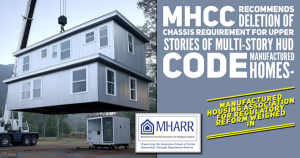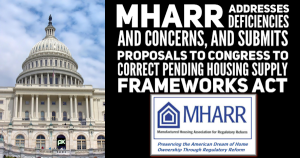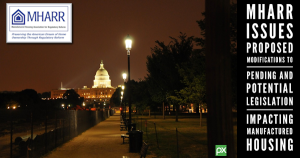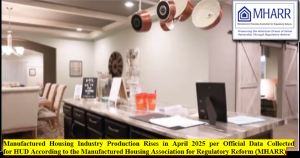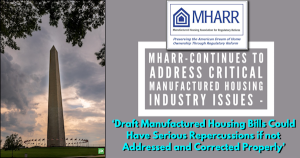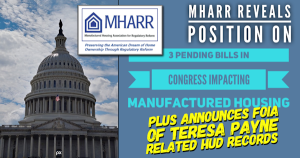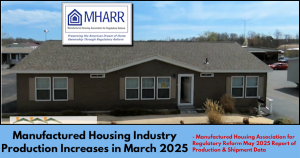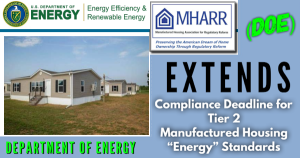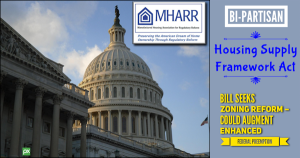“Wasted Manufactured Housing Opportunities Mount As The Clock Ticks Down”
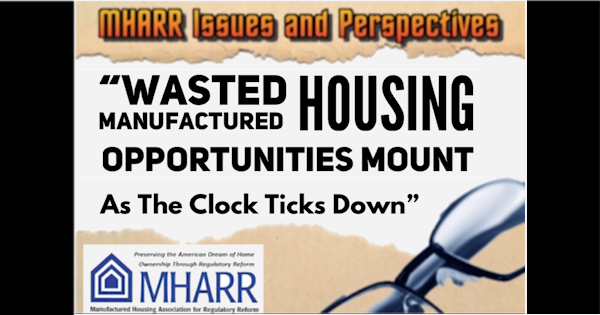
MHARR — ISSUES AND PERSPECTIVES
By Mark Weiss
At press time for this article, just four weeks remain before the November 3, 2020 presidential election. The election itself, as illustrated during the September 29, 2020 “debate,” presents a stark contrast for voters, and its outcome will produce equally stark policy contrasts for the manufactured housing industry and American consumers of affordable housing (as well as many others).
While the past four years under President Trump have featured policies that were at least designed to promote regulatory reform, the next four years (or more) could very well see those policies reversed. Whether – and to what degree – a more punitive regulatory perspective gains (or re-gains) traction in the nation’s capital, however, remains to be seen and will be a function of a number of political and administrative factors beyond the presidential election.
Given these polar opposites and the uncertainty inherent in the upcoming election, speculation regarding the outcome (and its potential impacts) becomes a significant and natural temptation. But speculation regarding an uncertain and unknowable future, is not the focus of this article. Its focus, rather, is on the “known” – i.e., on what has occurred over the past four years under the Trump Administration in relation to the manufactured housing industry, what can be learned from that information and analysis, and what lessons can and should be drawn from that experience going forward.
Certainly, the regulatory policies and outlook of the past four years have presented multiple — and, arguably, unparalleled — opportunities to achieve genuine and lasting reform in areas that have been major, long-term sore spots for both the industry and American consumers of affordable housing. Unfortunately, though, even an environment rich with opportunity does not guarantee results and sadly, after four years, it appears that those opportunities have largely been squandered. The question, then, is “why?” Why have those opportunities, after four years of highly favorable regulatory and administrative policies – and with good, beneficial laws for the industry and consumers already in place — failed to produce significant positive results for the industry and consumers? Why does HUD Code manufactured housing production remained mired at levels well below historic norms, while other segments of the housing industry experience significant growth? WHY?
MHARR, as a relatively small organization which – as committed by its founding Charter – specifically represents the manufacturing or “production” sector of the industry, has aggressively pursued regulatory and administrative reform under President Trump, and has arguably achieved successes disproportionate to its size including, but not limited to, the 2017 re-assignment of the former HUD manufactured housing program administrator – which was specifically and only sought by MHARR – and the 2017 withdrawal, by the U.S. Department of Energy, of egregious and potentially devastating proposed manufactured housing energy standards, the development of which were supported by the Manufactured Housing Institute (MHI) during an alleged “negotiated” rulemaking process. And while these successes were significant in and of themselves, much more could have been accomplished over the past four years – particularly (and even more importantly) with respect to the major post-production issues which continue to plague the industry (and have actually worsened in recent years) — if MHARR had been fully-supported in numerous other regulatory efforts (or at least not opposed) by MHI, the national industry association which consistently boasts that it represents all segments of the HUD Code industry.
No doubt, if a harsher regulatory climate does come to pass in 2021 – as it well may – the excuses from the usual quarters within the industry will rush forth like a swollen river, as will paeans to the need to “work with” the usual assortment of industry detractors in order to avoid, allegedly, the worst possible results.
But what about the missed opportunities of the past four years – such as those at HUD under Secretary Carson? Where did they go? What about that promised “top-to-bottom” regulatory review of the federal manufactured housing program? What about the hundreds of reform proposals submitted to the Office of Manufactured Housing Programs (OMHP)? What about the Executive Orders (13771 and 13777) requiring the re-evaluation of all agency regulations and the elimination or modification of those found to impair employment or the economy, among other things? What about the elimination of two existing regulations for each new one adopted? What about the publication or invalidation of sub-regulatory “guidance” under Executive Order 13891? And what about an appointed, non-career manufactured housing program administrator, as affirmatively required by law and as proposed by HUD and the Treasury Department in their housing finance “reform” plans? MHARR has consistently and aggressively pressed HUD on all of these matters at all levels, from the Secretary on down for the past four years, while the national representative of all industry segments has hosted speeches, tours and other confabs offering more in the way of … promises (as well as public relations and photo-ops), but no concrete results.
Needless to say, that’s a whole lot of “would have, could have and should have” right there, relating to existing HUD regulatory burdens and their damaging effects on the industry and its consumers. But what about the two majorpost-production issues that continue to severely restrict and limit the industry’s progress – i.e., discriminatory and exclusionary zoning mandates and HUD’s failure to act against them under its enhanced preemption authority as conferred by the Manufactured Housing Improvement Act of 2000, and the endlessly botched (or intentionally thwarted) implementation of consumer financing reform by Fannie Mae, Freddie Mac and the Federal Housing Finance Agency (FHFA) under the statutory “Duty to Serve Underserved Markets” (DTS) mandate?
What about those crucial issues? The 2000 reform law gives HUD all the power it needs to federally preempt state and local zoning provisions that discriminatorily exclude or restrict the placement of HUD Code manufactured homes in accordance with preemptive federal (i.e., HUD) standards and a statute which directs HUD, among other things, to “facilitate the availability of affordable manufactured homes and to increase homeownership for allAmericans.” (Emphasis added). Apparently, though, “all” – at least to HUD regulators – somehow means far less than “all,” as HUD has consistently allowed state and local officials over wide areas of the country, through obviously discriminatory zoning mandates, to exclude or severely limit the placement of mainstream manufactured homes, which are the single most affordable source of homeownership. Clearly, if Congress had meant to say “some,” or “a few,” or “some, but not all,” it could have done so in this provision of the law. But it did not, it said “all,” adding yet another promise to be honored in the breach (at least for the last 20 years) by HUD and its federal manufactured housing regulators — albeit without firm and decisive pushback from the organization which claims to represent all segments of the industry.
And DTS? As was pointed out in the September 2020 issue of “MHARR – Issues and Perspectives,” some twelve years after Congress enacted the Duty to Serve the manufactured housing consumer financing market (among others), 94-95% of the manufactured housing market and manufactured housing consumers remain completely unserved by Fannie and Freddie, including the entirety of its largest market segment, financed through personal property loans. And the “new class” of more costly hybrid “Cross-Mod” homes touted by MHI, Fannie, Freddie and the industry’s largest corporate conglomerates? According to a DTS “compliance” report submitted to FHFA, a grand total of six such homes were financed by Fannie Mae (none by Freddie Mac) in 2019, and of those, a whopping two were reportedly eligible for DTS credit. So, more than a decade after Congress adopted DTS as a remedy for Fannie and Freddie’s failure to serve the mainstream manufactured housing market, Fannie and Freddie are still failing to serve the overwhelming majority of the HUD Code market and mainstream manufactured housing consumers. And where is the firm and decisive pushback from the organization which claims to represent all segments of the industry?
Worse yet, as time drags on and on, even the absolutely minimal commitment by Fannie and Freddie to the manufactured housing market set forth in their original DTS implementation plans, continues to be whittled away. Thus, in its latest proposed 2020 DTS Plan modifications – submitted to FHFA September 15, 2020 – Fannie Mae seeks approval to back away from any further 2020 loan purchases under its “enhanced manufactured housing loan product for quality manufactured housing and purchase loans,” and instead, “replace loan purchases with expanded outreach and education activity.” Sure! And Freddie Mac, in its proposed 2020 Plan modification and 2021 extension proposal, totally eliminates its previously proposed “chattel pilot” program for 2019-2020 and its previously proposed purchase of 800-2,000 manufactured home chattel loans over the same period. Not content with that, though, it also would cancel its alleged “outreach” and education programs related to chattel lending over the same period. Again, where is the firm and decisive pushback from the organization which claims to represent all segments of the industry?
And lest anyone be confused over FHFA’s intent to seriously consider DTS stakeholder input on these “proposed” revisions at a scheduled October 16, 2020 “listening session,” or in written comments (due October 23, 2020), FHFA, in its Request for Input (RFI) regarding the proposed modifications, helpfully notes that it “expects to issue Non-Objections to the Enterprises’ proposed modifications … after considering … public input … by January 11, 2021.” So, it sounds like that “public input” will get about as much “consideration” from Fannie, Freddie and FHFA as it has in the past, which is zero to none.
And who does this help? Certainly not consumers and especially not mainstream manufactured housing consumers who use personal property (home only) financing. According to federal data from 2018, 91% of those consumers paid “high-cost” interest rates for their home loans (as reported, among other places, at a November 5, 2019 Freddie Mac symposium, where MHI was a participant). And while the number of consumers excluded from the HUD Code market altogether by these “high-cost” interest rates is not reported, the industry’s dominant portfolio lenders, well, they’re smiling … all the way to the proverbial bank.
Consequently, it should come as a shock to absolutely no one that national industry representatives other than MHARR, have spent most of the last four years promoting the supposed “new class” of much-less affordable “manufactured home” under DTS, while DTS implementation within the mainstream HUD Code manufactured housing market, and especially the dominant chattel sector, has gone virtually nowhere. And even that promotion – as ill-targeted as it is – has failed to produce results, with only two “Cross-Mod” homes supported by Fannie Mae for DTS credit in 2019, and further purchases in 2020 eliminated by Fannie’s proposed 2020 DTS Plan modifications. Again, the excuses (and diversions) abound, while time drags on and consumers suffer.
With one month remaining, then, before the election, the industry has made little-to-no progress whatsoever toward a meaningful and lasting resolution of the discriminatory zoning and consumer financing issues that have long hobbled both the industry and its consumers, under what is undoubtedly the most business-friendly and regulation-averse administration in nearly 30 years. Absent a last-minute blizzard of activity, therefore – and, again, regardless of the final outcome of the election — it is difficult to see how this qualifies as anything other than a disappointing failure by the broader industry to capitalize on a potentially unsurpassed opportunity to significantly change the landscape for manufactured housing in Washington, D.C.
If President Trump is re-elected, the industry still has a chance to achieve positive, elemental change, despite the precious four years that have needlessly been wasted. But that, unlike the squandered opportunities of the past for years, is anything but certain.
Mark Weiss
MHARR is a Washington, D.C.-based national trade association representing the views and interests of independent producers of federally-regulated manufactured housing.
“MHARR-Issues and Perspectives” is available for re-publication in full (i.e., without alteration or substantive modification) without further permission and with proper attribution to MHARR.
MHARR — ISSUES AND PERSPECTIVES
By Mark Weiss
At press time for this article, just four weeks remain before the November 3, 2020 presidential election. The election itself, as illustrated during the September 29, 2020 “debate,” presents a stark contrast for voters, and its outcome will produce equally stark policy contrasts for the manufactured housing industry and American consumers of affordable housing (as well as many others).
While the past four years under President Trump have featured policies that were at least designed to promote regulatory reform, the next four years (or more) could very well see those policies reversed. Whether – and to what degree – a more punitive regulatory perspective gains (or re-gains) traction in the nation’s capital, however, remains to be seen and will be a function of a number of political and administrative factors beyond the presidential election.
Given these polar opposites and the uncertainty inherent in the upcoming election, speculation regarding the outcome (and its potential impacts) becomes a significant and natural temptation. But speculation regarding an uncertain and unknowable future, is not the focus of this article. Its focus, rather, is on the “known” – i.e., on what has occurred over the past four years under the Trump Administration in relation to the manufactured housing industry, what can be learned from that information and analysis, and what lessons can and should be drawn from that experience going forward.
Certainly, the regulatory policies and outlook of the past four years have presented multiple — and, arguably, unparalleled — opportunities to achieve genuine and lasting reform in areas that have been major, long-term sore spots for both the industry and American consumers of affordable housing. Unfortunately, though, even an environment rich with opportunity does not guarantee results and sadly, after four years, it appears that those opportunities have largely been squandered. The question, then, is “why?” Why have those opportunities, after four years of highly favorable regulatory and administrative policies – and with good, beneficial laws for the industry and consumers already in place — failed to produce significant positive results for the industry and consumers? Why does HUD Code manufactured housing production remained mired at levels well below historic norms, while other segments of the housing industry experience significant growth? WHY?
MHARR, as a relatively small organization which – as committed by its founding Charter – specifically represents the manufacturing or “production” sector of the industry, has aggressively pursued regulatory and administrative reform under President Trump, and has arguably achieved successes disproportionate to its size including, but not limited to, the 2017 re-assignment of the former HUD manufactured housing program administrator – which was specifically and only sought by MHARR – and the 2017 withdrawal, by the U.S. Department of Energy, of egregious and potentially devastating proposed manufactured housing energy standards, the development of which were supported by the Manufactured Housing Institute (MHI) during an alleged “negotiated” rulemaking process. And while these successes were significant in and of themselves, much more could have been accomplished over the past four years – particularly (and even more importantly) with respect to the major post-production issues which continue to plague the industry (and have actually worsened in recent years) — if MHARR had been fully-supported in numerous other regulatory efforts (or at least not opposed) by MHI, the national industry association which consistently boasts that it represents all segments of the HUD Code industry.
No doubt, if a harsher regulatory climate does come to pass in 2021 – as it well may – the excuses from the usual quarters within the industry will rush forth like a swollen river, as will paeans to the need to “work with” the usual assortment of industry detractors in order to avoid, allegedly, the worst possible results.
But what about the missed opportunities of the past four years – such as those at HUD under Secretary Carson? Where did they go? What about that promised “top-to-bottom” regulatory review of the federal manufactured housing program? What about the hundreds of reform proposals submitted to the Office of Manufactured Housing Programs (OMHP)? What about the Executive Orders (13771 and 13777) requiring the re-evaluation of all agency regulations and the elimination or modification of those found to impair employment or the economy, among other things? What about the elimination of two existing regulations for each new one adopted? What about the publication or invalidation of sub-regulatory “guidance” under Executive Order 13891? And what about an appointed, non-career manufactured housing program administrator, as affirmatively required by law and as proposed by HUD and the Treasury Department in their housing finance “reform” plans? MHARR has consistently and aggressively pressed HUD on all of these matters at all levels, from the Secretary on down for the past four years, while the national representative of all industry segments has hosted speeches, tours and other confabs offering more in the way of … promises (as well as public relations and photo-ops), but no concrete results.
Needless to say, that’s a whole lot of “would have, could have and should have” right there, relating to existing HUD regulatory burdens and their damaging effects on the industry and its consumers. But what about the two majorpost-production issues that continue to severely restrict and limit the industry’s progress – i.e., discriminatory and exclusionary zoning mandates and HUD’s failure to act against them under its enhanced preemption authority as conferred by the Manufactured Housing Improvement Act of 2000, and the endlessly botched (or intentionally thwarted) implementation of consumer financing reform by Fannie Mae, Freddie Mac and the Federal Housing Finance Agency (FHFA) under the statutory “Duty to Serve Underserved Markets” (DTS) mandate?
What about those crucial issues? The 2000 reform law gives HUD all the power it needs to federally preempt state and local zoning provisions that discriminatorily exclude or restrict the placement of HUD Code manufactured homes in accordance with preemptive federal (i.e., HUD) standards and a statute which directs HUD, among other things, to “facilitate the availability of affordable manufactured homes and to increase homeownership for allAmericans.” (Emphasis added). Apparently, though, “all” – at least to HUD regulators – somehow means far less than “all,” as HUD has consistently allowed state and local officials over wide areas of the country, through obviously discriminatory zoning mandates, to exclude or severely limit the placement of mainstream manufactured homes, which are the single most affordable source of homeownership. Clearly, if Congress had meant to say “some,” or “a few,” or “some, but not all,” it could have done so in this provision of the law. But it did not, it said “all,” adding yet another promise to be honored in the breach (at least for the last 20 years) by HUD and its federal manufactured housing regulators — albeit without firm and decisive pushback from the organization which claims to represent all segments of the industry.
And DTS? As was pointed out in the September 2020 issue of “MHARR – Issues and Perspectives,” some twelve years after Congress enacted the Duty to Serve the manufactured housing consumer financing market (among others), 94-95% of the manufactured housing market and manufactured housing consumers remain completely unserved by Fannie and Freddie, including the entirety of its largest market segment, financed through personal property loans. And the “new class” of more costly hybrid “Cross-Mod” homes touted by MHI, Fannie, Freddie and the industry’s largest corporate conglomerates? According to a DTS “compliance” report submitted to FHFA, a grand total of six such homes were financed by Fannie Mae (none by Freddie Mac) in 2019, and of those, a whopping two were reportedly eligible for DTS credit. So, more than a decade after Congress adopted DTS as a remedy for Fannie and Freddie’s failure to serve the mainstream manufactured housing market, Fannie and Freddie are still failing to serve the overwhelming majority of the HUD Code market and mainstream manufactured housing consumers. And where is the firm and decisive pushback from the organization which claims to represent all segments of the industry?
Worse yet, as time drags on and on, even the absolutely minimal commitment by Fannie and Freddie to the manufactured housing market set forth in their original DTS implementation plans, continues to be whittled away. Thus, in its latest proposed 2020 DTS Plan modifications – submitted to FHFA September 15, 2020 – Fannie Mae seeks approval to back away from any further 2020 loan purchases under its “enhanced manufactured housing loan product for quality manufactured housing and purchase loans,” and instead, “replace loan purchases with expanded outreach and education activity.” Sure! And Freddie Mac, in its proposed 2020 Plan modification and 2021 extension proposal, totally eliminates its previously proposed “chattel pilot” program for 2019-2020 and its previously proposed purchase of 800-2,000 manufactured home chattel loans over the same period. Not content with that, though, it also would cancel its alleged “outreach” and education programs related to chattel lending over the same period. Again, where is the firm and decisive pushback from the organization which claims to represent all segments of the industry?
And lest anyone be confused over FHFA’s intent to seriously consider DTS stakeholder input on these “proposed” revisions at a scheduled October 16, 2020 “listening session,” or in written comments (due October 23, 2020), FHFA, in its Request for Input (RFI) regarding the proposed modifications, helpfully notes that it “expects to issue Non-Objections to the Enterprises’ proposed modifications … after considering … public input … by January 11, 2021.” So, it sounds like that “public input” will get about as much “consideration” from Fannie, Freddie and FHFA as it has in the past, which is zero to none.
And who does this help? Certainly not consumers and especially not mainstream manufactured housing consumers who use personal property (home only) financing. According to federal data from 2018, 91% of those consumers paid “high-cost” interest rates for their home loans (as reported, among other places, at a November 5, 2019 Freddie Mac symposium, where MHI was a participant). And while the number of consumers excluded from the HUD Code market altogether by these “high-cost” interest rates is not reported, the industry’s dominant portfolio lenders, well, they’re smiling … all the way to the proverbial bank.
Consequently, it should come as a shock to absolutely no one that national industry representatives other than MHARR, have spent most of the last four years promoting the supposed “new class” of much-less affordable “manufactured home” under DTS, while DTS implementation within the mainstream HUD Code manufactured housing market, and especially the dominant chattel sector, has gone virtually nowhere. And even that promotion – as ill-targeted as it is – has failed to produce results, with only two “Cross-Mod” homes supported by Fannie Mae for DTS credit in 2019, and further purchases in 2020 eliminated by Fannie’s proposed 2020 DTS Plan modifications. Again, the excuses (and diversions) abound, while time drags on and consumers suffer.
With one month remaining, then, before the election, the industry has made little-to-no progress whatsoever toward a meaningful and lasting resolution of the discriminatory zoning and consumer financing issues that have long hobbled both the industry and its consumers, under what is undoubtedly the most business-friendly and regulation-averse administration in nearly 30 years. Absent a last-minute blizzard of activity, therefore – and, again, regardless of the final outcome of the election — it is difficult to see how this qualifies as anything other than a disappointing failure by the broader industry to capitalize on a potentially unsurpassed opportunity to significantly change the landscape for manufactured housing in Washington, D.C.
If President Trump is re-elected, the industry still has a chance to achieve positive, elemental change, despite the precious four years that have needlessly been wasted. But that, unlike the squandered opportunities of the past for years, is anything but certain.
Mark Weiss
MHARR is a Washington, D.C.-based national trade association representing the views and interests of independent producers of federally-regulated manufactured housing.
“MHARR-Issues and Perspectives” is available for re-publication in full (i.e., without alteration or substantive modification) without further permission and with proper attribution to MHARR.



